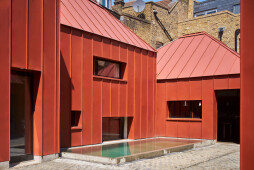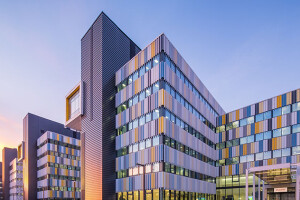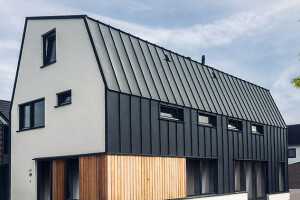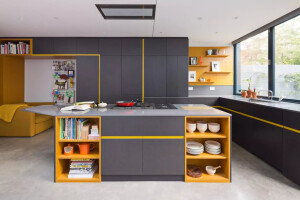The back land site of the Tin House is entered from a modest London street through a ‘massive’ Soanian brick double-height arch – a gateway to a remarkable domestic inner world.
Creating a secluded place was a priority. The architects’ response was to develop a low, inward-looking, tranquil courtyard that is open to the south yet offers privacy, both visual and acoustic. The design is a composition of different pavilions: six earth-coloured metal-clad pyramidal top-lit forms. The Tin House maximizes space through these six interconnected pyramidal pods where the colour coated steel GreenCoat PLX BT was specified for the roofs and faćades. This gave cohesiveness to the separate but conjoined units allowing the project to create a dialogue with the warm, earthy London brick which surrounds the site. GreenCoat PLX BT features a Bio-based Technology (BT) with a substantial portion of the traditional fossil part replaced by a bio-based alternative like rapeseed oil. This unique, patented solution by SSAB reduces the environmental footprint of the house significantly.
This modest and utilitarian finish accentuates the monolithic and sculptural quality of the design. A calm rectangular pool of water allows for condensation cooling and the sun’s reflections from the water bring the fac¸ades to life. Each pavilion accommodates a room. Secondary spaces such as toilets and stairs are hidden within the capacious double walls of the links between pavilions, so that the final design reads as an enfilade of generous top lit spaces. The pavilions are gently moulded to make efficient use of the site.
The roof shape has a low contour and maximizes spatial volume. This source of light from above brings the spaces to life. The roof-lights can be opened and on warm days the stack effect ensures that fresh cool air is drawn in from above the pool. The Pantheon and the work of James Turrell have influenced the design of the top lit pavilions.
As one moves through the building the layout gives a changing enfilade of vistas and views, the geometric forms accentuated by the simple utilitarian finishes. The brick fireplace mirrors the entrance gateway in its scale and texture and acts as a ‘touchstone’ at the heart of the composition, grounding the house around a hearth.
The pavilions are super- insulated (250 mm of PU foam) and relatively airtight. A heat-recovery air system ensures energy efficient ventilation throughout the colder months. Full of inventiveness, the cleverly detailed thick walls contain the services. The house has a beautiful balance of delight and is obviously an uplifting and practical place to live.
2-Aug-2016 The Tin House is set in a vibrant Victorian part of London. A disused, contaminated industrial site has been used to create a family home set around a tranquil courtyard.
A house has been separated into its constituent components; each room is a pavilion topped with a trapezoid rooflight. The rooms are used to create a composition that addresses the irregularities of the site and resolves the lack of privacy. The resulting top lit spaces respond to the changing moods of the day.
With the insertion of small support spaces in-between larger rooms the pavilions interconnect. Hiding staircases and cupboards in the thickness of the walls was inspired by plans of medieval Scottish castles.
The bedrooms have been designed like rooms in a monastery. Each cell has a desk with a view over the secluded courtyard. Each has a sink and a separate WC/shower. The beds are in the middle of the rooms under the rooflights; when lying in bed one can enjoy the changing sky and the stars. The bed-head is a piece of furniture, housing cupboards or a bathtub.
The warm earthy red cladding material on walls and roofs highlights the monolithic quality of each unit. Having variations on a theme, the diverse pavilions, is reminiscent of the composition found in music and nature. The whole thing is essentially a giant sculpture.
The building is hidden from the street and accessed via a small door set into a brick archway. One is led along a narrow cobbled street, and on turning a corner, the tranquil beauty of the sculpture surprises.
The six pavilions around a communal space with a pool and a tall chimney, are reminiscent of a Mediterranean village with a piazza and campanile. The architect has combined his Nordic sense of austerity with his love of Renaissance Italy.






















































